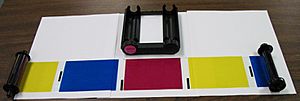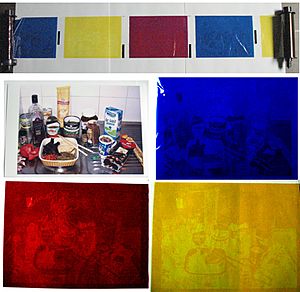Dye-sublimation printing facts for kids
Dye-sublimation printing is a cool way to print that uses heat to put special dyes onto different materials. You might hear it called "dye-sub printing" for short.
When this printing method was first named, people thought the dye went straight from a solid to a gas, skipping the liquid stage. This process is called sublimation. But later, scientists found out that the dye does become a liquid for a tiny bit. So, the more correct name is "dye diffusion." However, most people still use "dye-sublimation."
Long ago, dye-sublimation was used for special printers that put dye directly onto paper using heat. This was often for making test prints before big printing jobs. Today, you'll find this technology in printers for ID cards and special photo printers. Sometimes it's called "dye diffusion thermal transfer" (D2T2).
The term also covers another method called sublimation transfer printing. Here, a regular printer uses special ink or toner to print on a transfer sheet. Then, this sheet is pressed onto another material, like plastic or fabric, with heat. This transfers the dye to the final material. It's called "indirect" because the main material doesn't go through the printer itself.
Sometimes, people talk about direct dye sublimation. This is used in printing on fabric. The special dye-sub inks are printed right onto the fabric. Then, the fabric is heated to make the dyes stick, without needing a transfer sheet.
Contents
How Dye-Sublimation Printers Work
The Printing Process
Imagine a special printer that uses heat! Most dye-sub printers lay down one color at a time. The dye is on a ribbon made of polyester, and each color (like yellow, magenta, cyan) is on its own section. Each color section is the same size as the paper you're printing on. For example, a printer for 4x6 inch photos would have 4x6 inch color sections.
When printing, the printer moves the paper and one color section of the ribbon together. They pass under a special heated print head. This print head has tiny heating parts that change temperature super fast. They release different amounts of dye depending on how much heat is applied. The dye then soaks into the paper.
After one color is done, the printer moves the ribbon to the next color. It also slightly moves the paper out and back in. This whole process happens four or five times. First, the three main colors (yellow, magenta, cyan) are added to make the full picture. Sometimes, a black layer is added too. The very last step is adding a clear protective layer. This layer keeps your print safe from sunlight and moisture.
For printing ID cards, you need clear text and barcodes. These are printed using an extra black section on the ribbon. This black section works differently. Instead of the dye soaking in, a whole layer of black transfers from the ribbon to the card where needed.
Where You See Dye-Sub Printing
In Businesses and Industries
Dye-sub printing used to be only for big businesses or special printing jobs. It was used in places like hospitals for medical images, for checking graphic designs, for security documents, and in TV broadcasting.
Popular for Events and Photos
Today, it's super popular for event photography and photo booths. Think about getting a quick print at a party or a theme park! These places need fast, on-demand prints.
Affordable Printers for Home
Years ago, a company called Alps Electric made some of the first good dye-sub printers for home use. They cost around $500–$1,000, which made this technology available to more people. Now, you can find many dye-sub printers for as little as $100, especially small ones that print postcard-sized photos.
For ID Photos and Cards
Because these printers can make instant photos cheaply, they've replaced old instant cameras for things like ID photos and printing ID cards.
Desktop and Photo Booth Use
Many companies sell small dye-sub printers for your desk. They are also used in photo kiosks and photo booths. Some companies even offer tools for software developers. This means they hope other businesses will use their printers to create new systems.
Event Photographers Love Them
Photographers at events also use these small dye-sub photo printers. This technology lets them print and sell high-quality photos right away at the event. They don't need a lot of equipment to do it.
How Fast Do They Print?
Dye-sub printers use heat to transfer dye. So, their speed depends on how fast the heating parts can change temperature. Heating them up is quick. But cooling them down, especially when changing from a dark color to a light one, takes more time. That's why these printers often have a fan to help cool the print head. Some printers use multiple print heads to speed things up.
A typical home dye-sub printer can print a 4x6 inch photo in about 45 to 90 seconds. Bigger, more powerful printers can be much faster. For example, some can print a 4x6 photo in under 7 seconds! A great thing is that the finished print is completely dry as soon as it comes out of the printer.
Dye-Sub vs. Inkjet Printing
Dye-sublimation printing has always been known for its smooth, continuous colors. This means each tiny spot on the print can be any color. It looks a lot like a traditional photo.
Inkjet printers, on the other hand, spray tiny drops of ink. While they can make the drops different sizes and place them carefully, each drop is still just one color. So, an inkjet print is made of many tiny dots of ink that mix to create colors. If you look closely with a magnifying glass, you can see the individual dots. In the past, inkjet prints weren't as good as dye-sub prints. But today's inkjets use super tiny drops and many ink colors, making very high-quality prints.
Dye-sub printing has some cool benefits over inkjet. First, the prints are dry and ready to touch right away. Also, the print head doesn't move back and forth, so there are fewer parts that can break. The whole process is very clean because there's no liquid ink to spill. These things make dye-sub printers generally more reliable than inkjet printers.
However, dye-sub printers also have some downsides. The color ribbons and the print head must match the size of the paper. Also, only special coated paper or certain plastics can accept the dye. This means dye-sub printers can't print on as many different types of materials as inkjet printers can.
The dyes spread a tiny bit before they soak into the paper. This means the prints aren't super sharp. For photos, this can make them look very natural. But for things like graphic design, this slight blurriness can be a problem.
Another thing is that a lot of dye is wasted with each print. Most of the dye on the four color sections might not be used for a typical picture. Once a section of the ribbon is used, even for just one tiny dot, that part can't be used again. Because most printers use one long roll of ribbon, all four color sections are used for every print, even if you don't need all the colors. Printing in black and white doesn't save dye either, as the color sections are still used up.
For places that print secret documents, dye-sub printers can be a security risk. A perfect "negative" image of what was printed stays on the used ribbon sections. If someone gets the used ribbon, they can unroll it and see everything that was printed. So, these used ribbons should be destroyed carefully. Even for home users, someone could get your old ribbons from the trash and see your photos! Since the ribbons are plastic, the images can last for many years.
Also, dye-sub papers and ribbons are sensitive to oils from your skin. These oils can stop the dye from transferring properly. They also need to be free of dust. Dust can cause small colored blobs on your prints. Most dye-sub printers have filters to help with this. Finally, dye-sub printers aren't the best for printing black and white photos with very deep blacks or for avoiding color shifts.
Sublimation Transfer Printing
Sublimation transfer printing is a digital printing method that uses full-color designs. It works well with polyester fabrics and materials coated with a polymer. At first, it was used for printing on polyester clothes. Now, it's also common for decorating clothes, signs, banners, and fun items like phone cases, plaques, coffee mugs, and mouse pads.
First, the images are printed onto special heat-resistant transfer paper. The design is printed as a mirror image of what you want the final product to look like. Then, this transfer paper is pressed onto the final material using a heat press.
In the past, large printers for transfer paper were modified plotters that used toner. But now, most are large inkjet printers that use special inks. For smaller prints, inkjet printers are also most common, though there are also special dye-sublimation laser printers available.
To move the image from the paper to the material, you need a heat press machine. This process combines the right amount of time, temperature, and pressure. Different materials need different settings. This heat will transfer the dyes into the material at a tiny, molecular level. Most sublimation dyes become active at about 350 degrees Fahrenheit (175 degrees Celsius). However, a range of 380 to 420 degrees Fahrenheit (195 to 215 degrees Celsius) is usually best for the brightest colors.
The result of this process is a print that is almost permanent, has high detail, and is full of color. Because the dyes become part of the material at a molecular level, the prints won't crack, fade, or peel under normal use. The fabric is permanently dyed, so you can wash it without hurting the image quality.
Here are some good things about dye-sublimation compared to other ways of printing on fabric:
- The images are permanent and won't peel or fade.
- The dye doesn't build up on the fabric, so it feels smooth.
- Colors can be super bright because the dye bonds with the clear fibers of the fabric.
- You can get truly smooth color changes, just like in a photograph.
- The image can be printed all over the item, even right to the edges.
Piezo Inkjet Transfer Printing
There are two main types of dye sublimation inks for piezo inkjet transfer printers. The most common is water-based dye sublimation ink. This works in both small desktop printers and large industrial printers. The other type is solvent dye sublimation ink, used in some large-format printers with specific print heads.
Because digital fabric printing is growing so fast, dye sublimation inks are becoming more and more popular for printing on fabrics with digital inkjet printers.
The speed of large-format piezo inkjet printers using water-based dye sublimation ink keeps getting faster. They can print from 18 square meters per hour (in a smaller 44-inch wide printer) to over 3,000 square meters per hour (in a very fast industrial fabric printer).
Direct Dye-Sublimation Fabric Printing
In this type of digital fabric printing, an inkjet printer prints dye-sublimation inks right onto the fabric. After printing, the fabric is heated in a special oven or on a heated roller. This heat makes the dyes spread and stick permanently to the fabric.
See also
 In Spanish: Impresora de sublimación para niños
In Spanish: Impresora de sublimación para niños
- Barcode printer
- Card printer
- ID card printer
- Label printer
- Photo printer
- Thermal transfer printing



